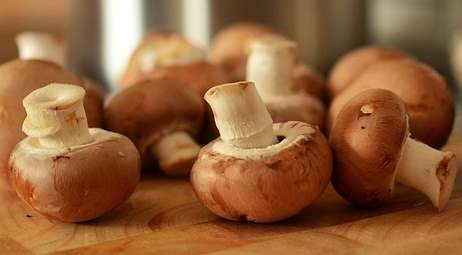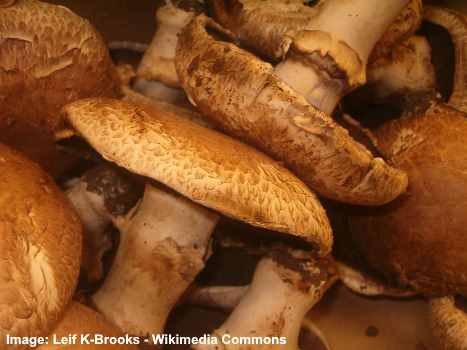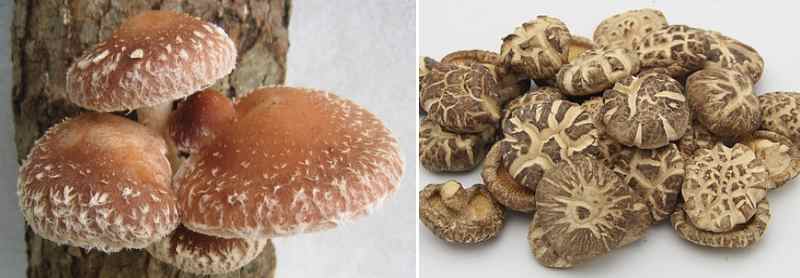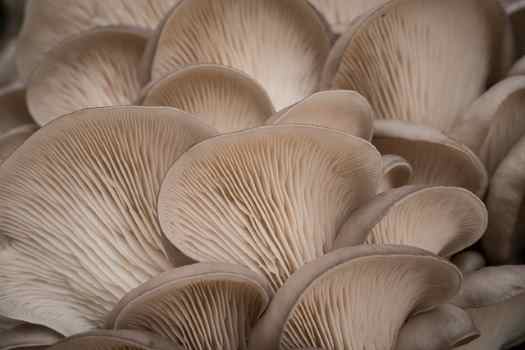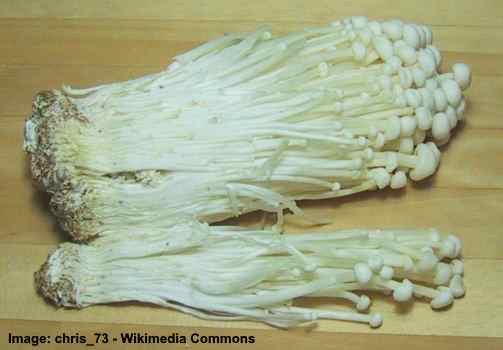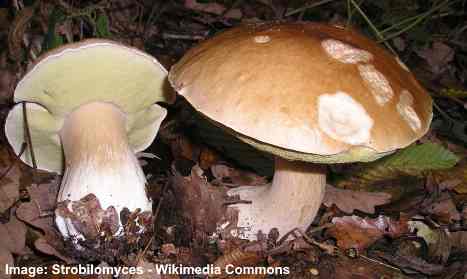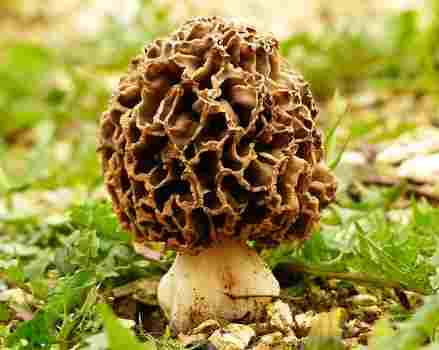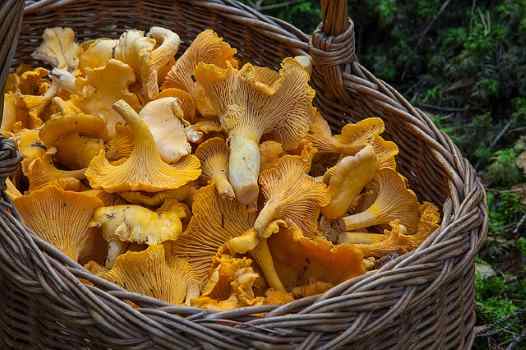Types of Edible Mushrooms (Including Wild Edible Mushrooms) – With Pictures
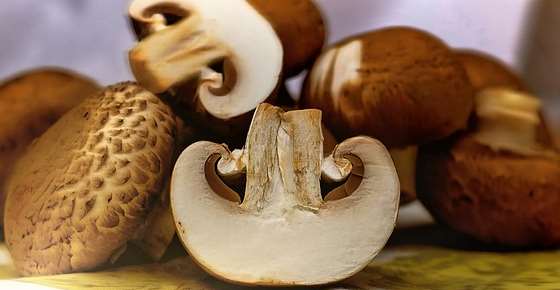
There are many types of edible mushrooms that are delicious to eat and are good for you. Some varieties of edible mushrooms such as white button, portobello, or shiitake varieties are generally cultivated commercially. There are also types of wild edible mushrooms such as chanterelles, porcini, or morels that you can usually find by foraging in the forest.
Mushrooms are actually a type of fungi that used as a vegetable in cooking. In fact, eating these types of fungi also has many health benefits due to their nutritional value.
Of course, not all types of mushrooms are good for eating. There are a number of varieties of poisonous mushrooms, some of which look just like edible wild mushrooms. Also, some mushroom varieties have hallucinogenic properties and are not used for food.
In this article, you will learn about various types of edible mushrooms – both commercially produced ones and the kind you can find growing wild in the forest. You will also find out helpful tips on storing mushrooms and how to prepare them for cooking.
Precautions When Foraging for Edible Wild Mushrooms
If you decide to pick your own mushrooms that grow wild, then you need to be careful to only pick edible ones.
In the wild, it can sometimes be difficult to tell if a mushroom is poisonous. Some edible wild mushrooms have toxic look-alike and eating them can result in serious consequences. Consuming the wrong type of wild mushroom can cause gastrointestinal upset, organ failure, and even death. (1)
The National Capital Poison Center recommends that if you decide to forage for wild mushrooms, it is best to have a mushroom expert with you. A mycologist (mushroom expert) can tell by examining mushrooms if they are safe to eat or not. (2)
You should also avoid picking mushrooms in areas that are heavily polluted. Heavy metals can accumulate in mushrooms and these can be bad for your health.
Types of Edible Mushrooms (With Pictures)
First of all, let’s look at some of the best varieties of edible mushrooms that are generally available for sale in the supermarket.
Of course, all of the fungi on this list of edible mushrooms also grow in the wild and can be found growing in forests, fields, pastures, and parks.
White Button Mushrooms
White button mushrooms (Agaricus bisporus) are one of the most popular types of edible mushrooms.
This common mushroom has a white or grey flat cap, short stems, and firm flesh. Young varieties of button mushrooms have pinkish gills under the cap that turn dark brown as the mushroom matures.
Other names for white button mushrooms include champignon mushroom, table mushroom, or the common mushroom.
The popularity of white button mushrooms and their mild taste means that they are commonly used in cooking. These small mushrooms are good sources of B-group vitamins and phosphorus. (3)
Studies into the health benefits of this common type of mushroom show that they have immune-boosting properties. Eating white button mushrooms may help stimulate certain enzymes that can help reduce your risk of infection. (4)
Crimini (Cremini) Mushrooms
Crimini mushrooms are another type of the Agaricus bisporus variety and are among the commonest edible fungi in the world.
Crimini mushrooms look similar to button mushrooms but they have a meatier texture and more pronounced earthier flavor. Many people say that crimini are better tasting mushrooms than the button variety.
Other names for crimini brown mushrooms include Italian brown mushrooms, chestnut mushroom, Swiss brown, or Roman brown mushroom.
Compared to button mushrooms, crimini mushrooms have better nutritional content. For example, there is more calcium, phosphorus, and potassium in these common brown mushrooms. Like button mushrooms, these crimini brown mushrooms are good dietary sources of B vitamins. (5)
One of the reasons that eating crimini mushroom is good for you is that they may help reduce inflammation. Studies have shown that certain edible mushroom varieties such as crimini stimulate antigen cells that help inhibit inflammatory responses. (6)
Portobello (Portabella) Mushrooms
Portobello mushrooms are large edible mushrooms and are crimini or button mushrooms that have grown for longer.
Portobellos (Agaricus bisporus) have a large wide flat cap that can be on average 6” (15 cm) in diameter.
Unlike its smaller varieties, portobello mushrooms are often grilled or baked whole and stuffed with a filling. Cooked portobello mushrooms have a chewy meaty texture and its flesh tastes smoky and earthy.
This big edible mushroom has a similar nutritional profile as its smaller versions. However, some studies have found that grilling cultivated portobello mushrooms increases its vitamin D content. Interestingly, if you leave the portobello in the sun for 15 minutes before cooking you can also increase its vitamin D content by over 25%. (6)
Shiitake Mushrooms
People describe shiitake (Lentinula edodes) mushrooms as one of the best-tasting mushrooms you can buy.
Shiitake mushrooms are native to Asia and are a type of edible tree mushroom. Shiitakes are small to medium-sized mushrooms with thin stems. The brown caps of these exotic mushrooms have a distinctive curled rim.
These edible cultivated and wild mushrooms are also called “black mushrooms,” “black forest mushrooms,” or “golden oak mushrooms.”
Although you can find shiitakes growing on decaying trees in the wild in Asian countries, you are more likely to find them in supermarkets or Asian stores in Western countries.
Similar to most mushrooms, shiitake mushrooms are a good dietary source of B vitamins and have moderate amounts of minerals. Dried shiitake mushrooms have a better nutrient profile gram for gram than their fresh varieties. (7, 8)
In Asian countries, shiitake mushrooms are used for medicinal purposes. Scientific studies have also shown that they help boost immunity and lower inflammation. Extracts from shiitake mushrooms also have antimicrobial properties. (9, 10)
Oyster Mushrooms
Oyster mushrooms are another type of edible tree mushroom that grows in the wild and is also cultivated for culinary purposes.
Varieties of oyster mushrooms generally have broad, fan-like caps that have a wavy appearance. The mushrooms can range in color from dark brown caps to striking white caps that seem to fan out from tree trunks. Oyster mushrooms have a meaty, firm flesh and have a mild, nutty flavor.
Types of oyster mushroom include the “Aspen oyster mushroom” (Pleurotus populinus), the “Indian oyster” (Pleurotus pulmonarius), and the “Tree oyster mushroom” (Pleurotus ostreatus).
Most varieties of oyster mushrooms are good sources of potassium, phosphorus, and protein. (11)
According to some studies, oyster mushrooms have many health-promoting benefits. (12)
Enoki Mushrooms
Enoki mushrooms (Flammulina velutipes) are a type of long skinny white mushroom that has tiny caps and grow in clusters.
These long stem mushrooms can grow up to 4” (12 cm) in length and look like pieces of string or noodles. That is one of the reasons why these long skinny mushrooms are used in Asian dishes in place of noodles. Because they have a mild, sweet taste, they go well in many dishes.
Similar to other types of edible mushrooms, eating enoki mushrooms can add towards your daily intake of B-group vitamins, potassium, magnesium, and iron. (13)
Are there any health benefits to adding tasty enoki mushrooms to your diet?
Studies have found that these white long stem mushrooms have compounds that may help lower blood pressure, reduce cholesterol, and improve cognitive performance. Researchers are also examining how extracts from F. velutipes could be used in treating cancer. (14)
Lab trials on mice have found that consuming edible mushrooms such as enoki and shiitake varieties can help prevent the accumulation of fat and boost gut health. (15)
Lion’s Mane
Lion’s mane (Hericium erinaceus) is one of the more unusual types of mushrooms that are safe to eat.
This type of edible fungi certainly doesn’t look like other varieties on the list of edible mushrooms. This type of mushroom grows on trees and looks like white pom poms. The fibrous base it covered by thin strands that dangle freely. Lion’s mane has a chewy flesh when cooked that some say tastes like scallops or lobster.
Studies on the health benefits of lion’s mane mushrooms have found that these are nutritional fungi. Compounds in these unusual mushrooms have been shown to have antibiotic, anticancer, anti-diabetic, and cardio-protective properties. As with other mushrooms, lion’s mane has immune-boosting properties. (16, 17)
Because they tend to grow high up on trees, they are difficult to find in the wild. However, you can buy these delicious mushrooms in Asian stores or order the dried variety online.
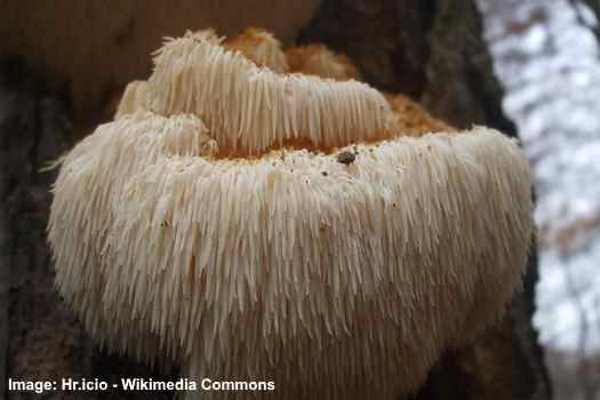
Types of Wild Edible Mushrooms
Some types of mushrooms that you can eat are difficult to cultivate and as a result, are generally only found growing wild.
Porcini Wild Edible Mushrooms
Porcini mushrooms (Boletus edulis) are some of the best-tasting mushrooms you can eat and they add a nutty flavor to many dishes.
For mushroom foragers, porcini mushrooms are the king of the forest. They are fairly easy to identify in the wild and because they are an expensive wild mushroom, they are a desirable mushroom to find.
Other names for porcini mushrooms include “cep,” “California king bolete,” or “Penny bun.”
Porcini mushrooms are also some of the largest wild mushrooms that are edible. The large brown cap can grow up to 12” (30 cm) in diameter. Some of the largest porcini mushrooms can weigh up to 2 lbs. (1 kg)!
These big edible mushrooms are also a good source of nutrients such as vitamin B12. Varieties of Boletus fungi have been linked to lowering blood pressure and increasing “good” cholesterol. Porcini mushrooms are also a good source of phenolic compounds that help improve your general health. (18, 19, 20)
Using dried porcini mushrooms in culinary dishes can give soups, risottos, stews, and other dishes a nutty, earthy flavor. (21)
Morel Mushrooms
Morel (Morchella esculenta) mushrooms are on the list of the most unusual edible wild mushrooms because they look like a large elongated walnut growing on a white stem.
Many people love these fancy mushrooms because they have an intense meaty flavor with earthy overtones.
Because morels are hard to find in the wild and difficult to cultivate, they are quite expensive mushrooms. You can usually only find these strange-looking mushrooms in the spring.
Morels also have good nutritional value and contain calcium, iron, potassium, magnesium, B vitamins, and vitamin D. (22)
Studies have also found that morels have many medicinal uses. Properties in morel mushrooms have been shown to have antioxidant, anti-inflammatory, and anticancer properties. Similar to other types of mushrooms, morels also help to strengthen the immune system. (23)
Similar to black truffles, morels are prized mushrooms that are very expensive.
Chanterelle Mushrooms
Chanterelle mushrooms are a common type of wild mushroom used for cooking.
Chanterelles (from the Cantharellus genus) have a bright golden color with smooth caps and long gills that run down the stems. Because of their yellow colors, mushrooms foragers can easily spot these edible forest mushrooms. However, they do have a poisonous look-alike called “Jack-o-Lanterns.”
The most notable nutrient in chanterelles is potassium. However, they also contain calcium, iron, and magnesium, vitamin D, and vitamins from the B group. (24, 18)
Medical research has found that extracts from certain varieties of chanterelle have anti-inflammatory and wound-healing properties. (25)
Wild mushrooms such as chanterelles can absorb heavy metals from polluted soil. For that reason, the results from some studies recommend blanching chanterelles for between 5 and 15 minutes to reduce levels of heavy metals. (26)
Maitake Mushrooms
Maitakes are a type of edible wild mushroom that grows at the base of trees during the fall.
Maitakes (Grifola frondosa) grow as a cluster of mushroom caps with wavy edges that can be up to 3” (7 cm) in diameter. This type of edible tree mushroom can become huge with some weighing up to 100 lbs. or 45 kg! Because of this, people refer to maitakes as the “king of mushrooms.”
Large maitake mushrooms are edible, but their tough fibrous texture is unpleasant to eat. If you want to pick this type of wild edible mushroom, look for younger and smaller fungi growths.
Maitake mushrooms are a good source of dietary protein and fiber. This tree fungi also contains minerals such as potassium, calcium, and magnesium. (27)
Lab trials have found that extracts from maitake mushrooms could have potential in treating breast cancer, lowering cholesterol, and treating type 2 diabetes. (28, 29, 30)
Truffles – Edible Mushrooms that Grow in the Wild
Truffles are sought-after black mushrooms that are among some of the most expensive wild mushrooms you can buy.
There are actually many varieties of truffles from the Tuberaceae family that you can eat. Apart from black truffles, there are white truffles, burgundy truffles, and even a rare type of mushroom called the garlic truffle.
True truffle mushrooms are found underground near the base of trees. Truffles can be consumed raw or cooked and are a good source of protein, fiber, vitamins, and minerals. (31)
The health benefits of eating black truffles or white truffles are due to their antioxidant and anti-inflammatory properties. (32, 33)
If you want to buy truffles to add some delicacy to your meals, black truffles are usually less expensive than the white varieties.
How to Store Mushrooms
The best way to store fresh mushrooms is to put them in a paper bag and keep them in the refrigerator. The paper bag will help to absorb excess moisture and this is also a reason not to store them in the crisper drawer.
Mushrooms will usually keep for a week in the refrigerator. If you want to store them for longer, you should freeze them or dry them.
Before you freeze mushrooms, it’s best to chop them up and cook them first. This is because mushrooms contain high amount of water, and freezing them raw can make them mushy. Once cooled, put them in a freezer bag where they will keep for up to 12 months.
How to Clean Wild Edible Mushrooms
If you go mushroom picking, the best way to care for your wild edible treats is to use a small knife to cut the stems and then immediately clean away debris.
Carry the delicate mushrooms in a basket rather than a plastic bag. This will help to prevent wild mushrooms from becoming damaged or squashed as you are foraging.
When you get home, use a pastry brush to clean away any remaining debris and then briefly rinse the fungi under running water. Don’t soak mushrooms as they will absorb water.
Discard any wild mushrooms you are not familiar with.
Store wild edible mushrooms in the same way you would store store-bought cultivated mushrooms.


